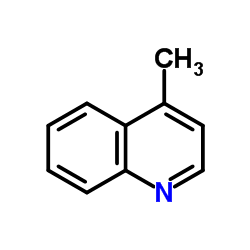lepidine

lepidine structure
|
Common Name | lepidine | ||
|---|---|---|---|---|
| CAS Number | 491-35-0 | Molecular Weight | 143.185 | |
| Density | 1.1±0.1 g/cm3 | Boiling Point | 262.0±0.0 °C at 760 mmHg | |
| Molecular Formula | C10H9N | Melting Point | 9-10 °C(lit.) | |
| MSDS | Chinese USA | Flash Point | 106.1±11.3 °C | |
| Symbol |

GHS07 |
Signal Word | Warning | |
|
Time-of-flight accurate mass spectrometry identification of quinoline alkaloids in honey.
Anal. Bioanal. Chem 407 , 6159-70, (2015) Time-of-flight accurate mass spectrometry (TOF-MS), following a previous chromatographic (gas or liquid chromatography) separation step, is applied to the identification and structural elucidation of quinoline-like alkaloids in honey. Both electron ionization... |
|
|
Direct, catalytic, and regioselective synthesis of 2-alkyl-, aryl-, and alkenyl-substituted N-heterocycles from N-oxides.
Org. Lett. 16(3) , 864-7, (2014) A one-step transformation of heterocyclic N-oxides to 2-alkyl-, aryl-, and alkenyl-substituted N-heterocycles is described. The success of this broad-scope methodology hinges on the combination of copper catalysis and activation by lithium fluoride or magnesi... |
|
|
A Programmed DNA Marker Based on Bis(4-ethynyl-1,8-naphthalimide) and Three-Methane-Bridged Thiazole Orange.
Chemistry 21 , 16623-30, (2015) Two large conjugated naphthalimide derivatives with or without three-methane-bridged thiazole orange (TO3; i.e., compounds 1 a and 2 a, respectively) were designed and synthesized. The fluorescence of the naphthalimide group in compound 1 a at λ=532 nm initia... |
|
|
Microbial metabolism of quinoline and related compounds. XIX. Degradation of 4-methylquinoline and quinoline by Pseudomonas putida K1.
Biol. Chem. Hoppe-Seyler 374 , 479-488, (1993) A bacterial strain, designated K1, which utilizes 4-methylquinoline and quinoline as sole source of carbon, nitrogen and energy was isolated from soil. Based on its morphological and physiological characteristics, it was classified as Pseudomonas putida biova... |
|
|
Carcinogenicity of quinoline, 4- and 8-methylquinoline and benzoquinolines in newborn mice and rats.
Food Chem. Toxicol. 26(7) , 625-9, (1988) The relative tumorigenic activity of quinoline, 4-methylquinoline, 8-methylquinoline, and all three isomeric benzoquinolines was evaluated in newborn CD-1 mice and Sprague-Dawley rats. In the newborn-mouse bioassay, 0.25, 0.5 and 1.0 mumol of each compound in... |
|
|
Facile, one-step production of niacin (vitamin B3) and other nitrogen-containing pharmaceutical chemicals with a single-site heterogeneous catalyst.
Chemistry 14(8) , 2340-8, (2008) Niacin (3-picolinic acid), which is extensively used as vitamin B3 in foodstuffs and as a cholesterol-lowering agent, along with other oxygenated products of the picolines, 4-methylquinoline, and a variety of pyrimidines and pyridazines, may be produced in a ... |
|
|
Aerobic biodegradation of 4-methylquinoline by a soil bacterium.
Appl. Environ. Microbiol. 62(8) , 2910-4, (1996) Methylquinolines and related N-heterocyclic aromatic compounds are common contaminants associated with the use of hydrocarbons in both coal gasification and wood treatment processes. These compounds have been found in groundwater, and many are known mutagens.... |
|
|
Spectroscopic studies on 2-[2-(4-methylquinolin-2-yl)hydrazono]-1,2-diphenylethanone molecule and its metal complexes.
Spectrochim. Acta. A. Mol. Biomol. Spectrosc. 74(4) , 869-74, (2009) The electronic absorption spectra of a hydrazone: 2-[2-(4-methylquinolin-2-yl)hydrazono]-1,2-diphenylethanone (BHQ) derived from 2-hydrazino-4-methylquinoline and 1,2-diphenylethan-1,2-dione (benzil) have been studied in various solvents of different polariti... |
|
|
Potent mutagenic potential of 4-methylquinoline: metabolic and mechanistic considerations.
Biol. Pharm. Bull. 19(4) , 541-6, (1996) 4-Methylquinoline (4-MeQ) showed an extraordinarily potent mutagenicity when compared to quinoline and isomeric methylquinolines. The major metabolite of 4-MeQ was 4-hydroxymethylquinoline, which was not mutagenic under the assay condition employed. Deuterati... |
|
|
Sphingomonas sp. strain Lep1: an aerobic degrader of 4-methylquinoline.
Can. J. Microbiol. 45(7) , 623-6, (1999) Strain Lep1, isolated from a bacterial consortium capable of aerobic degradation of 4-methylquinoline (4-MQ), was chosen for further characterization as it was the only member of the consortium able to grow on 4-MQ in pure culture. Lep1 was identified as a Sp... |